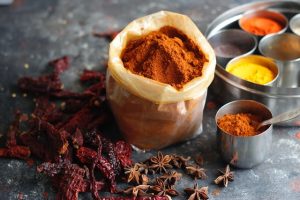If you think you can handle the heat, try out these chilies to maximise your scoville units.
“I don’t like spicy food” is the biggest lie ever told. You just haven’t met the right chili yet. Peppers are delicious and come with a wide array of benefits that include reducing inflammation, stabilizing blood sugar, and helping to fight cancer. The Scoville scale measures the amount of capsaicin present in a pepper. Capsaicin is what makes peppers taste hot. The higher the number on the scale, the hotter the pepper—and the more capsaicin it contains.**
1) Bhut Jolokia
This chili has a rating of 1,041,427 Scoville heat units (SHUs). That’s about 200 times hotter than a jalapeño! This pepper is native to India and is also known as ghost chili or ghost pepper.**
2) Trinidad Scorpion Butch T
This chili has a rating of 1,463,700 SHUs, which makes it one of the hottest peppers in the world. The name comes from its shape; it looks like a scorpion’s tail with a stinger at the end.**
3)
A handful of fresh green chilies and some cooked red ones
Chilies are the fruit of capsicum peppers and vary in size, shape, colour and heat intensity. The heat is due to a chemical called capsaicin and the amount varies from pepper to pepper, but don’t let that stop you enjoying them. In fact, I would encourage you to embrace the heat and get creative in the kitchen by trying out these lesser-known varieties.
Scoville units are used to rate the heat of peppers on a scale from 0 (as in bell peppers) all the way up to 3,000,000 (as in pure capsaicin). The Scoville scale is named after its creator, American pharmacist Wilbur Scoville. His method, devised in 1912, is known as the Scoville Organoleptic Test.
Fresh chilies can be eaten raw or cooked whole or chopped. They can be added fresh to salsas and sauces or dried for later use. Dried chilies can be used whole or ground into chili powder or flakes. A general rule for using chilies: the smaller they are, the hotter they are! So be careful about how much you use – I tend to err on the side of caution by
The Scoville scale is the measurement of the pungency (spicy heat) of chili peppers and other spicy foods, as recorded in Scoville Heat Units (SHU) based on the concentration of capsaicinoids, among which capsaicin is the predominant component. Next time you’re at the grocery store and find yourself needing some spice for a dish, beware: these are some of the spiciest chilies on Earth.
1. Habanero
The habanero chillies score higher on the Scoville scale and can hit up to 350,000 SHUs! They are small in size but pack a punch. These chilies are prized for their fruity flavour and intense heat. They are used in many different food dishes to add some pungency and flavour.
2. Scotch Bonnet
If you thought habaneros were hot, then brace yourself because scotch bonnets are even hotter! These chilies can range from 100,000 to 350,000 SHUs. These fiery peppers have a heat that lingers long after your meal is over but also have an amazing sweet fruitiness that makes it great for any jerk recipe.
3. Red Savina Habanero
This pepper is
You may have heard of the Scoville scale, but how much do you know about it?
The level of heat in a chilli pepper is measured according to the Scoville Scale, which was created by American pharmacist Wilbur Scoville in 1912.
Scoville units measure capsaicin concentration, the main chemical responsible for all that heat.
Pure capsaicin clocks in at a whopping 16,000,000 SHU’s (Scoville Heat Units).
Hot sauce is measured in Scovilles too. For example Tabasco clocks in with 2,500 – 5,000 SHU’s.
You can find some of the hottest chillies around here at Flavourly!
Meet the Dragon’s Breath chili. It’s officially the world’s hottest chili, according to the Chile Pepper Institute at New Mexico State University in Las Cruces. It scores a whopping 2.48 million on the Scoville scale, which measures spiciness.
In comparison, a jalapeno pepper scores anywhere between 2,500 and 8,000 Scoville heat units (SHU) on the Scoville scale. Most hot sauces are in the 100 to 500 SHU range. The Dragon’s Breath pepper is so hot that it could be deadly if eaten – only 0.001% of people will be able to eat it without any discomfort and even touching this pepper with bare hands can cause severe burning sensations.
The chilli was developed by Mike Smith, a farmer from St Asaph, Wales, who has now applied for it to be recognised by Guinness World Records as the world’s hottest chilli pepper
He said: “It’s not been tried orally. I’ve tried it on the tip of my tongue and it just burned and burned.” He added: “It’s so hot it could kill you.”
Mr Smith said he had taken precautions when handling the peppers and wore rubber gloves when planting them at his farm in St Asaph
Chilies are the world’s most widely eaten spice!
The Scoville scale measures the “heat” of peppers. Intermediate values are achieved using dilution, which is a more accurate method for arriving at a final rating than doing the dilutions by taste.
Here is a list of the top 10 hottest chillies in the world:
1) Carolina Reaper (HP22B) – 1,569,300 SHU
2) Trinidad Moruga Scorpion – 2,009,231 SHU
3) 7 Pot Douglah – 1,853,936 SHU
4) 7 Pot Primo – 1,469,000 SHU
5) Trinidad Scorpion “Butch T” – 1,463,700 SHU
6) Naga Viper – 1,382,118 SHU
7) Infinity Chilli – 1,067,286 SHU
8) Naga Morich – 923,000 SHU
9) Bhut Jolokia (Ghost Chilli) – 855,000 SHU
10) Red Savina Habanero – 577,000 SHU
The Scoville scale is the measurement of the pungency (spicy heat) of chilli peppers and other spicy foods, as recorded in Scoville Heat Units (SHU) based on the concentration of capsaicinoids, among which capsaicin is the predominant component.
Capsaicin is a chemical compound that stimulates chemoreceptor nerve endings in the skin, especially the mucous membranes.The number of Scoville heat units (SHU) indicates the amount of capsaicin present. The greater the number of Scolville heat units, the hotter the chilli pepper.
The scale is named after its creator, American pharmacist Wilbur Scoville. His method, devised in 1912, is known as the Scoville Organoleptic Test.
An alternative method for quantitative analysis uses high-performance liquid chromatography, making it possible to directly measure capsaicinoid content. This method yields results in American Spice Trade Association pungency units.
Since law enforcement personnel are more concerned with the potential for harm than feelings of discomfort or potential medical benefits from consuming hot food, law enforcement agencies generally use pepper spray extract rated in Major Capsaicinoids (MC), or CRC Units.

